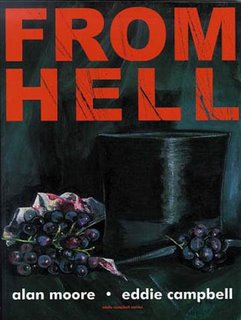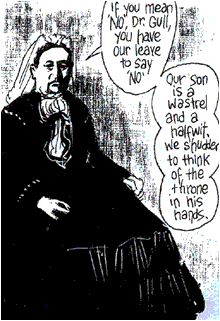 Alan Moore assumiu-se como um pioneiro do movimento iniciado nos anos 80 que facultou a elevação do estatuto da 9ª arte para lá das "histórias de quadradinhos" para crianças (e adultos pouco letrados). Depois de um esboço com V for Vendetta (recentemente adaptado para o cinema), conseguiu-o com Watchmen, uma graphic novel que tanto para leitores como para a crítica revolucionou o mundo dos super-heróis e transformou a experiência narrativa da banda desenhada em algo muito próximo da profundidade narrativa do romance, o que juntamente com a arte de Dave Gibbons, o artista que colocou a história de Moore em imagens, deu origem à única banda desenhada a receber um Hugo Award e a figurar entre os 100 melhores romances (de língua inglesa) da Time Magazine.
Alan Moore assumiu-se como um pioneiro do movimento iniciado nos anos 80 que facultou a elevação do estatuto da 9ª arte para lá das "histórias de quadradinhos" para crianças (e adultos pouco letrados). Depois de um esboço com V for Vendetta (recentemente adaptado para o cinema), conseguiu-o com Watchmen, uma graphic novel que tanto para leitores como para a crítica revolucionou o mundo dos super-heróis e transformou a experiência narrativa da banda desenhada em algo muito próximo da profundidade narrativa do romance, o que juntamente com a arte de Dave Gibbons, o artista que colocou a história de Moore em imagens, deu origem à única banda desenhada a receber um Hugo Award e a figurar entre os 100 melhores romances (de língua inglesa) da Time Magazine.Depois de Watchmen (e inúmeras outras obras), Alan Moore voltou a surpreender com From Hell. Quando se sugere que o tema central de From Hell é Jack o Estripador, Moore corrige dizendo que os crimes de Whitechapel são apenas um pretexto para um retrato profundo da época vitoriana e do advento do século XX. Tal como Watchmen, e indo até um pouco mais longe, From Hell é mais que uma simples graphic novel, entrando, nalguns aspectos, no campo do romance e inclusivamente do ensaio – especulativo mas fundamentado nas poucas fontes existentes, também elas carecendo de rigor histórico absoluto. É, acima de tudo, uma obra grandiosa, com as suas mais de 500 pranchas mais 66 páginas de anexos, 42 das quais com notas que, acima de tudo, fundamentam e explicam a teorização sobre o tema através de consulta bibliográfica e anotações de cariz histórico.
Trata-se, portanto, de ficção pontuada por fundamentos históricos que servem para dar coerência narrativa e verosimilhança (pergunto-me... será que Dan Brown já leu From Hell?...). Vemos, assim, os crimes hediondos de Jack o Estripador como uma trama real encabeçada pela própria Rainha Vitória que se vê forçada a tomar medidas desesperadas para salvar a honra da Coroa Britânica, chamando o cirurgião maçónico Sir William Gull para resolver o caso de uma situação de chantagem que tem por base o facto de o Príncipe Albert Victor ter engravidado e casado com Annie Crook, uma lojista da classe trabalhadora. Por muito apetecível e sedutora que esta versão dos acontecimentos nos pareça, sabemos que, e apesar do confronto com fontes documentais – por vezes escassas e contraditórias – estamos no terreno pantanoso da suposição, o que no entanto não torna a obra menos excitante.
Eddie Campbell acompanha de forma competente o argumento de Moore com um desenho de traço fino com silhuetas e sombras extraídas de abundantes traços paralelos ou cruzados, ou mesmo muitas vezes com um fundo totalmente negro – obrigatoriamente com arte-final a preto e branco para mais facilmente criar o ambiente nocturno e sombrio das ruas londrinas do século XIX.
From Hell são 16 capítulos (mais anotações e anexos) que facilmente prendem o leitor, quer nos momentos mais gráficos, com várias páginas seguidas de pranchas silenciosas, muitas vezes com imagens fortes cujo impacto nem o preto e branco consegue atenuar, quer nos muitos momentos com características mais de romance que de banda desenhada, em que, apesar de nada de novo surgir nas imagens, o texto é crucial para o desenvolvimento da profundidade das personagens. Numa história em que nada são certezas ao longo do desenrolar da acção, a única certeza que fica é a de que Alan Moore continuará certamente a surpreender-nos com obras-primas que fazem jus à sua crescente aceitação - no meio dos comic books e fora dele.
Alan Moore turned out to be a pioneer of the movement started in the 1980s which allowed the rise of the 9th art reputation beyond the "comic book for children" (and illiterate adults). After a draft with V for Vendetta (recently adapted for cinema), he made it with Watchmen, a graphic novel that - both for readers and critics - revolutionised the world of super-heroes and transformed the narrative experience of comic books into something very close to the narrative depth of the novel, which, together with the artwork of Dave Gibbons, the artist that put Moore’s story in pictures, gave birth to the only comic book that has received a Hugo Award and is positioned among Time Magazine’s 100 best (English language) novels.
After Watchmen (and a myriad of other works), Alan Moore surprised once more with From Hell. When it is suggested that From Hell’s main subject is Jack the Ripper, Moore corrects this assumption by saying that the Whitechapel crimes are only a pretext for an insightful portrait of the Victorian Age and the advent of the 20th century. Just like Watchmen, and going even a bit further, From Hell is more than a mere graphic novel, exploring, in some aspects, the field of the novel and inclusively the essay – speculative but grounded in the few existing sources, these latter also lacking absolute historical accuracy. It is, most of all, an immense work, with its more than 500 boards plus 66 pages of annexes including 42 with annotations that, above all, ground and explain the theorisation on the subject through bibliographical research and historical annotations.
It is, therefore, fiction punctuated with historical groundings that are used to provide narrative coherence and likelihood (I wonder… has Dan Brown already read From Hell?...). Thus we see Jack the Ripper’s heinous crimes as a royal plot headed by Queen Vic herself who is forced to take desperate measures to safeguard the honour of the British Crown, calling the mason surgeon Sir William Gull to solve the case of a blackmail situation based on the fact that Prince Albert Victor had knocked up and married Annie Crook, a working-class shop attendant. Though this version of events sounds amusing and appealing, we know that (and despite the confrontation with documental sources – sometimes scarce and contradictory) we are in the muddy lands of supposition, which nevertheless doesn’t make it less exciting.
Eddie Campbell proficiently follows Moore’s script with an artwork made up of thin outlines with silhouettes and shadows obtained from copious parallel or crossed lines, or even, quite often, with a totally black background – forcibly with a black and white final art to recreate more easily the nocturnal and gloomy ambience of the 19th century London streets.
From Hell is a set of 16 chapters (plus annotations and annexes) that easily takes hold of the reader, both in the more graphic moments, with several pages in a row with silent boards, often with strong images with an impact that can’t be lightened by the black and white, and in the numerous moments which resemble more the novel than the comic book, in which, although nothing new shows up in the images, the text is critical for the development of the characters’ depth. In a story where nothing is certain throughout the action, the only certainty that remains is that Alan Moore will surely keep surprising us with master works that confirm his increasing acceptance – both in the comics medium and outside it.
After Watchmen (and a myriad of other works), Alan Moore surprised once more with From Hell. When it is suggested that From Hell’s main subject is Jack the Ripper, Moore corrects this assumption by saying that the Whitechapel crimes are only a pretext for an insightful portrait of the Victorian Age and the advent of the 20th century. Just like Watchmen, and going even a bit further, From Hell is more than a mere graphic novel, exploring, in some aspects, the field of the novel and inclusively the essay – speculative but grounded in the few existing sources, these latter also lacking absolute historical accuracy. It is, most of all, an immense work, with its more than 500 boards plus 66 pages of annexes including 42 with annotations that, above all, ground and explain the theorisation on the subject through bibliographical research and historical annotations.
It is, therefore, fiction punctuated with historical groundings that are used to provide narrative coherence and likelihood (I wonder… has Dan Brown already read From Hell?...). Thus we see Jack the Ripper’s heinous crimes as a royal plot headed by Queen Vic herself who is forced to take desperate measures to safeguard the honour of the British Crown, calling the mason surgeon Sir William Gull to solve the case of a blackmail situation based on the fact that Prince Albert Victor had knocked up and married Annie Crook, a working-class shop attendant. Though this version of events sounds amusing and appealing, we know that (and despite the confrontation with documental sources – sometimes scarce and contradictory) we are in the muddy lands of supposition, which nevertheless doesn’t make it less exciting.
Eddie Campbell proficiently follows Moore’s script with an artwork made up of thin outlines with silhouettes and shadows obtained from copious parallel or crossed lines, or even, quite often, with a totally black background – forcibly with a black and white final art to recreate more easily the nocturnal and gloomy ambience of the 19th century London streets.
From Hell is a set of 16 chapters (plus annotations and annexes) that easily takes hold of the reader, both in the more graphic moments, with several pages in a row with silent boards, often with strong images with an impact that can’t be lightened by the black and white, and in the numerous moments which resemble more the novel than the comic book, in which, although nothing new shows up in the images, the text is critical for the development of the characters’ depth. In a story where nothing is certain throughout the action, the only certainty that remains is that Alan Moore will surely keep surprising us with master works that confirm his increasing acceptance – both in the comics medium and outside it.
photo credits: From Hell © Alan Moore and Eddie Campbell 1999








No comments:
Post a Comment